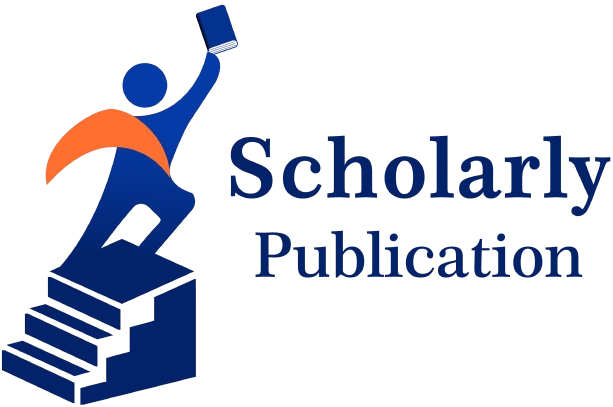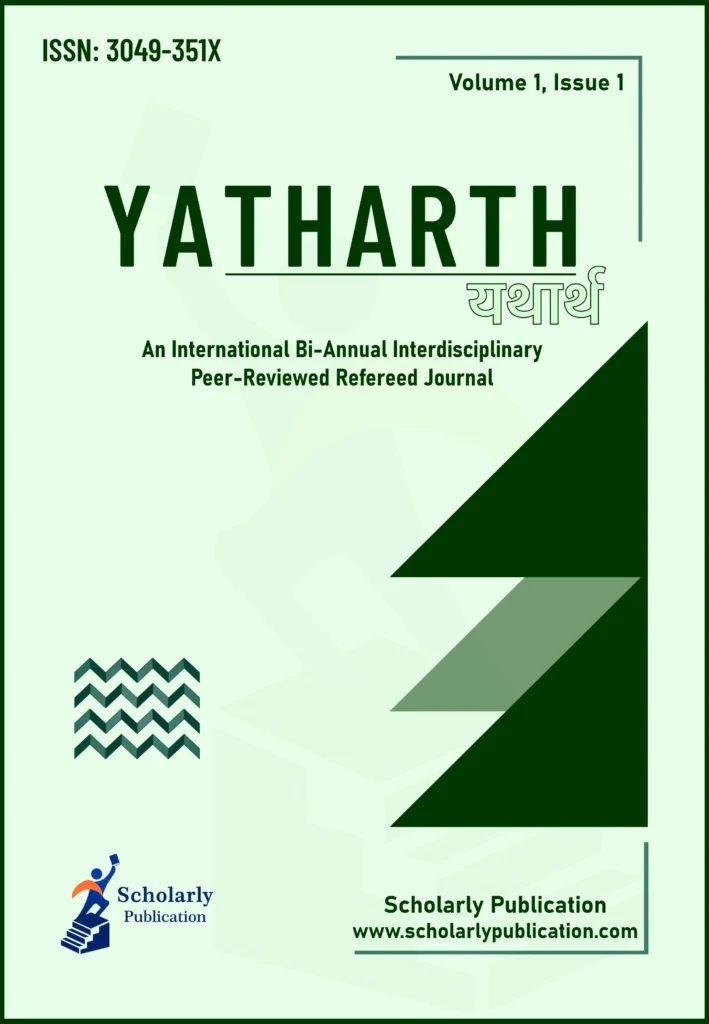AUM in Vedic and Upanishadic Literature: A Comprehensive Analysis of its Essence and Meaning
Volume 1, Issue 1, Article Number: 251008 (2025)
Home >> Yatharth >> Volume 1, Issue 1
Santoshi Kumari1,* | Jagwanti Deswal1
1School of Yoga, Nirwan University, Jaipur – 303305, Rajasthan (India)
*Corresponding Author: santoshikumari355@gmail.com
Received: 18 February 2025 | Revised: 18 March 2025
Accepted: 19 March 2025 | Published Online: 25 March 2025
DOI: https://doi.org/10.5281/zenodo.15084743
© 2025 The Authors, under a Creative Commons license, Published by Scholarly Publication
Abstract
This research analyzes the AUM concept as it exists within Vedic literature. Through literature Vedic and philosophical texts of India commonly use the syllable AUM (OM) as a key hymn. Several Vedic literatures contains the concept of AUM which this study investigates. Sruti refers to one of several names for the Vedas as it means “heard” knowledge while Apauruseya signifies “not human” creation and Shastra functions as an instructional guide. Both Agama and Amnaya have identical meanings with Veda. The revelation nature of Veda earns it its title as the leading source of information. The Vedic knowledge exists in its original form after passing through generations because sages reportedly heard it during meditative states thus becoming known as Mantra seers. The wise men transmitted their learned knowledge by spoken word to upcoming generations after its acquisition. The Vedas have managed to surmount time because they were transmitted orally from one generation to the next. The study found that Aum functions as protective force for peace which offers liberation during death. Through Vedic rituals people worship the Aum because it symbolizes the Supreme Self and it is certain that honoring Aum means honoring the highest Self.
Keywords
AUM, Vedas, Rigveda, Samaveda, Yajurveda, Atharvaveda
References
- Vivekananda, R. (2012). Practical yoga psychology. Yoga Publications Trust, Munger.
- Deussen, P. (2010). The philosophy of the Upanisads. Cosimo.
- Jackson, C. A., Pathirana, T., & Gardiner, P. A. (2016). Depression, anxiety and risk of hypertension in mid-aged women: A prospective longitudinal study. Journal of Hypertension, 34, 1959–1966.
[View Article] [Google Scholar]
- Sood, M., Chadda, R. K., Deb, K. S., Bhad, R., Mahapatra, A., Verma, R., & Mishra, A. K. (2017). Scope of mobile phones in mental health care in low-resource settings. Journal of Mobile Technology in Medicine, 5, 33–37.
[View Article] [Google Scholar]
- Salk, R. H., Hyde, J. S., & Abramson, L. Y. (2017). Gender differences in depression in representative national samples: Meta-analyses of diagnoses and symptoms. Psychological Bulletin, 143, 783–822.
[View Article] [Google Scholar]
- Salzano, A., D’Assante, R., Heaney, L. M., Monaco, F., Rengo, G., Valente, P., Pasquali, D., Bossone, E., Gianfrilli, D., Lenzi, A., Cittadini, A., Marra, A. M., & Napoli R. (2018). Klinefelter syndrome, insulin resistance, metabolic syndrome, and diabetes: Review of literature and clinical perspectives. Endocrine, 61, 194–203.
[View Article] [Google Scholar]
- Bangasser, D. A., Eck, S. R., Telenson, A. M., & Salvatore, M. (2018). Sex differences in stress regulation of arousal and cognition. Physiology & Behavior, 187, 42–50.
[View Article] [Google Scholar]
- Sun, L., Wang, Y., Zhou, T., Zhao, X., Wang, Y., Wang, G., & Gang, X. (2019). Glucose metabolism in Turner syndrome. Frontiers in Endocrinology, 10, 49.
[View Article] [Google Scholar]
- Beck, G. L. (2019). Sacred music and Hindu religious experience: From ancient roots to the modern classical tradition. Religions, 10, 85.
[View Article] [Google Scholar]
- Crockett, M. A., Martínez, V., & Jiménez-Molina, Á. (2020). Subthreshold depression in adolescence: Gender differences in prevalence, clinical features, and associated factors. Journal of Affective Disorders, 272, 269–276.
[View Article] [Google Scholar]
- Inbaraj, G., Rao, R. M., Ram, A., Bayari, S. K., Belur, S., Prathyusha, P. V., Sathyaprabha, T. N., & Udupa, K. (2022). Immediate effects of OM chanting on heart rate variability measures compared between experienced and inexperienced yoga practitioners. International Journal of Yoga, 15, 52-58.
[View Article] [Google Scholar]
- Rajagopalan, A., Krishna, A. & Mukkadan, J. (2023). Effect of Om chanting and Yoga Nidra on depression anxiety stress, sleep quality and autonomic functions of hypertensive subjects – a randomized controlled trial. Journal of Basic and Clinical Physiology and Pharmacology, 34, 69-75.
[View Article] [Google Scholar]
- Rajput, J. M., & Girase, J. M. (2022). A comprehensive review on chanting of sacred sound “Om” (Aum) as a healing practice. International Journal of Pharmaceutical Research and Applications, 7, 1748–1753.
[View Article] [Google Scholar]
- Barazzetti, L., Garcez, A., & Bairros, F. (2022). Does sleep quality modify the relationship between common mental disorders and chronic low back pain in adult women?. Sleep Medicine, 96, 132–139.
[View Article] [Google Scholar]
- Pundir, A., & Chauhan, A. (2023). Positive effects of ‘AUM’ chanting on mental health well-being. Traditional Medicine, 4, 15.
[View Article] [Google Scholar]
- Chaudhry, N., Bhandari, R. B., & Gaur, V. (2023). Yoga perspective on personal excellence and well-being. Journal of Ayurveda and Integrative Medicine, 14, 100717.
Cite This Article
S. Kumari and J. Deswal, “AUM in Vedic and Upanishadic Literature: A Comprehensive Analysis of its Essence and Meaning,” Yatharth 1(1) (2025) 251008. https://doi.org/10.5281/zenodo.15084743
Rights & Permission
This is an open access article published under the Creative Commons Attribution (CC BY) International License, which allows unrestricted use, distribution, and reproduction in any medium, provided the original work is properly cited. No permission is needed to reuse this content under the terms of the license.
For uses not covered above, please contact the Scholarly Publication Rights Department.

